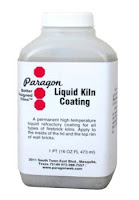How to
How to Kiln
Kiln Lid Flakes
Kiln Repair Directory
Kiln Repairs
Kiln Troubleshooting
Kilns
Liquid Kiln Coating
maintenance
Paragon Kilns
Paragon Liquid Kiln Coating
When the Kiln Lid Flakes...
Great information about kiln lid repairs from our friends at Paragon...
At Paragon, they coat the inner lid surface of all kilns to reduce brick dust. Sometimes the refractory coating is too thick so, it will blister and flake off when the kiln is fired. An especially thick coating looks like a network of peeling cracks similar to a dried mud puddle. This cracking is due to the difference in expansion between the firebricks and the coating. Conversely, correctly applied kiln coating will look like it disappeared after the kiln has been fired.
First, shake the container very well! Then, pour some of the coating into a bowl. Make sure to stir it just before you apply it to the firebricks. Apply the coating with a large, soft sponge. Moisten the sponge with water; then squeeze out the excess... this is a very important step! Dip the sponge into the bowl of kiln coating. Wipe the coating over the lid surface.
Do not let excess coating run into the element grooves of the kiln. Applying a light coat will prevent this from happening. If the coating drips along the edges of the grooves, remove by wiping a cotton swab or rag along the groove.
Many people have asked us... "What is the difference between kiln cement and Liquid Kiln Coating? Can a lid be coated with a thin mixture of kiln cement?" The answer is YES! Kiln cement thinned with water will work as a lid coating. Liquid Kiln Coating is simply a mixture of kiln cement, fine brick dust, a gumming agent, and water.
The great news is that lid coating lasts for several years. So, it's not something you need to worry about on a daily basis. But, if you start getting kiln brick dust on your work, maybe it's time to re-apply.
The great news is that lid coating lasts for several years. So, it's not something you need to worry about on a daily basis. But, if you start getting kiln brick dust on your work, maybe it's time to re-apply.
Some kilns such as the Paragon CS-14S allow you to upgrade to a fiber top, which helps to keep your kiln cleaner and reduces the chance of debris in your pieces.
Explore more
- 10 things before Kiln purchase
- 12 key digital controller
- 12-key controller
- 120v
- 120v Kilns
- 240 volt kiln
- 3 key digital controller
- Aerospace Equipment
- Ah Ohm Meter
- An Ohm Meter
- Analog Multimeter
- Arnold Howard
- Art Decorations
- Art Glass
- Ask Arnold
- Bartlett 3k 3-key Controller
- Bartlett Controllers
- Bartlett RTC 1000
- Be Smart First Aid Kit
- Blade
- Body Shop Oven
- Brick Kilns
- Brining home your new kiln
- Bubble Control
- Bullseye Glass
- Bullseye Kiln-Glass Education
- Bullseye Shelf Primer
- Bullseye Tips
- Bullseye Videos
- Buy Kiln
- Capped Dichroic Glass
- Ceram-a-Glass
- Ceram-a-Glass Kilns
- Ceramic
- Ceramic Fiber Kiln
- Ceramic Glass Kilns
- Ceramic Insulators
- Ceramic Kiln
- Circuit Breakers
- Clamshell kilns
- Coated Dichroic Glass
- COE
- Coefficient of Expansion
- Color Line Dot Bowls
- Color of The Year
- Colored Glass
- Colored Kilns
- Colors
- Commercial Furnace
- Commercial Kilns
- Cone Bowl
- Cone Bowl Molds
- Consult licensed electrician
- Conventional Kiln
- Copper Enameling
- Cork Clay
- Covington Engineering
- Custom Furnace
- Custom Kinl
- Custom Oven
- Customize Color
- Decorative Fuse
- Design
- Dichroic Glass
- Different Types of Relays
- Digital Controller
- Digital Multimeter
- Dual Media Kilns
- Electrical Current
- Electrical Kilns
- Electrical Tape
- Element Pins
- Elements Pins
- Enameling
- Evenheat
- Evenheat Copper Kiln
- Evenheat GTS 2541-13
- Evenheat Kiln - GTS2541
- Evenheat Kilns
- Evenheat Kilns & Ovens
- Evenheat Kilns & Ovens LB Series
- Evenheat Kingpin 88
- Evenheat Perfect Fire Kiln
- Evenheat RampMaster 2
- Evenheat Set Pro 3-key
- FAQS
- Fiber Kilns
- Fiber Papers
- Fiber Shelf
- Fibonacci Sequence
- Fire Enamels
- Firebrick
- Firebrick Kiln
- Firebrick Kiln Repair Kit
- Firing
- Firing costs
- Firing Stages of Glass
- First Aid Kit
- Foam sheet
- Free Customize
- Front Load Glass Kilns
- Front Load Kilns
- Front-Loading Kiln
- furnace
- Fuse Glass
- Fused Glass
- Fusing
- Fusing Ideas
- Fusing Plates
- gas fired kilns
- GFCI
- Glass
- Glass Art
- Glass Bottle Slumping
- Glass Cutting
- Glass Design
- Glass Design Ideas
- Glass Fusing
- Glass Fusing Kiln
- Glass Jewelry
- Glass Kiln
- Glass Kilns
- Glaze
- Glaze Firing
- Glossary
- Ground Connectors
- Ground Fault Circuit Interrupter
- Hake Brush
- Heat Treat Ovens
- Heat Treating
- Heat-Treating Kiln
- How much costs kilns run
- How to
- How to Kiln
- Howard Kiln Services
- Hybrid Kilns
- Industrial Kilns
- Industrial Ovens
- Jen-Ken
- Jen-Ken 3-key Controller
- Jen-Ken Ceram-a-Glass 2422
- Jen-Ken Ceram-a-Glass JK22
- Jen-Ken Fuse Cube 9/9
- Jen-Ken JK215 Ceram-a-Glass
- Jen-Ken Kiln
- Jen-Ken Kilns
- Johnson & Johnson Red Cross All Purpose First Aid Kit
- Kiln Academy
- Kiln Accessories
- Kiln Art
- Kiln Care
- Kiln Circuits
- Kiln Con
- Kiln Controller
- Kiln Costs
- Kiln Dead Short
- Kiln Delivery
- Kiln Digital Relays
- Kiln Electrical Costs
- Kiln Equipment
- Kiln fires too quickly
- Kiln fires too slowly
- Kiln First Aid Kits
- Kiln Furniture
- Kiln Glossary
- Kiln Ground Connectors
- Kiln Heat Source
- Kiln Heating Element
- Kiln help
- Kiln Lid Flakes
- Kiln Lifespan
- Kiln Maintenance
- Kiln not heating properly
- Kiln Oven
- Kiln Parts
- Kiln Peephole
- Kiln Peephole Plug
- Kiln Q&A
- Kiln Relays
- Kiln Relays Health
- Kiln Repair Directory
- Kiln Repairs
- Kiln Safety
- Kiln Safety Equipment
- Kiln Safety Tips
- Kiln shape
- Kiln Size
- Kiln Spare Parts
- Kiln Technicians
- Kiln Tips
- Kiln Troubleshooting
- Kiln Wash
- kiln-buying
- kiln-education
- Kilnforming
- KilnFrog
- Kilns
- Kilns Q&A
- Knife making kilns
- Knivesmaking
- Lab Kiln
- Larger Kilns
- Learn More
- Liquid Kiln Coating
- maintenance
- Math
- Mechanical Relays
- Medipoint Splinter Out Splinter Remover
- Mercury Relay
- Metal
- Metal Clay
- Moving your studio kiln
- Multimeter
- Natural Burn Ointment
- Octagon Kiln
- Olympic 1818HE
- Olympic 186GFE
- Olympic HB86E
- Olympic hb89
- Olympic Kilns
- Olympic Square 186GFE
- Opaque Glass Base
- Orton
- Orton Autofire
- Orton Controllers
- Orton Sentry 2.0 Micro Processor
- Orton VentMaster
- outlet
- oven
- Pantone Color of the Year
- PAPYROS Shelf Paper
- Paragon
- Paragon A-24B
- Paragon Caldera Digital
- Paragon CS-26
- Paragon Fiber Fuse-16
- Paragon Fusion 10
- Paragon Janus27
- Paragon Kiln - GL 24ADTSD
- Paragon Kiln Fusion 10
- Paragon Kilns
- Paragon Liquid Kiln Coating
- Paragon SC-3
- Parts Oven
- Plate Slumping
- Platemaking
- Porcelain Kilns
- Pottery
- Pottery Kiln
- Prepare your kiln from storm damage
- Project
- projects
- Psychology of Colors
- Pyrolite
- Quartz enclosed tubes
- Quartz Tubing
- Quick Tips
- Raku Firing
- Raku Kilns
- Raku Pottery
- Rampmaster Controllers
- Ready-to-Ship
- Relay Coil
- Relay Q&A
- Relays for Kilns
- Relays Lifespan
- Rings capped with Opaline
- Round Shelf
- Safety
- Screwdrivers
- Self supporting cones
- Sentry Controller
- Sentry Xpress 3.0 3-Key Controller
- Shelf Paper
- Side Firing Kilns
- Slow Ramping Kiln
- Slumping
- Sma
- Small Suction Lifter
- Smaller Kilns
- Smart Controller
- Sparkle Glass
- Stacking Kilns
- Table Top Vitigraph Stand
- Test Voltage
- Thermocouple
- Tint Glass
- Tint Overlay
- Tips
- Tool and Die Equip
- Tool and Die Equipment
- Top Firing Kilns
- Top Load Glass Kiln
- Top Load Kiln
- Top Loading Ceramic Kiln
- Top things to do to your kiln
- Top-Loading Kiln
- Transparent Glass base
- Troubleshooting
- Ultra Violet
- Ultra Violet Color of the Year
- Uncapped Dichroic Glass
- VentMaster
- Vitigraph
- Voltage
- Wall Mountable Eye and Skin Flush Station
- What type of Plugs do kilns need
- where to buy a kiln
- Where to put kiln








Leave a comment